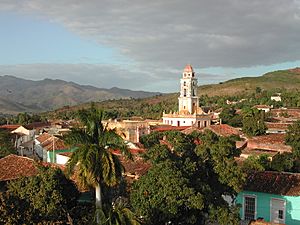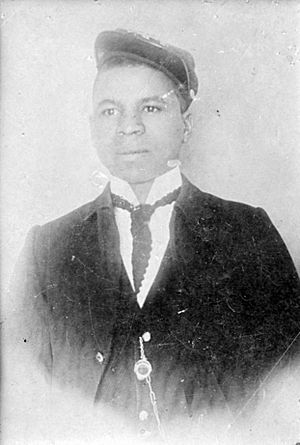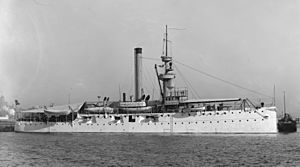Battle of Tayacoba facts for kids
Quick facts for kids Battle of Tayacoba |
|||||||
|---|---|---|---|---|---|---|---|
| Part of the Spanish–American War | |||||||
 Present-day view of Trinidad |
|||||||
|
|||||||
| Belligerents | |||||||
| Commanders and leaders | |||||||
| Strength | |||||||
| 100 | 34 1 gunboat |
||||||
| Casualties and losses | |||||||
| Unknown | 8 killed and wounded | ||||||
The Battle of Tayacoba took place on June 30, 1898. It was a special mission by American forces during the Spanish–American War. Their goal was to deliver supplies and help to Cuban rebels who were fighting for their freedom from Spain. The battle happened near a place called Tayacoba in Cuba.
Contents
What Led to the Battle?
On June 25, 1898, two American steamships, the Fanita and the Florida, left Key West. They were joined by a gunboat named USS Peoria. These ships carried important supplies like troops, ammunition, and weapons. They even had two dynamite guns and many rifles.
The supplies were meant for Cuban rebels fighting for their independence. General Emilio Núñez led 650 Cuban fighters on board. There were also 50 American soldiers from the Tenth U.S. Cavalry. These soldiers were led by First Lieutenant Carter P. Johnson. Another 25 volunteers, known as "Chanler's Rough Riders," were also part of the group.
First Landing Attempt
The ships first tried to land on June 29 near the port of Cienfuegos. However, this area was too heavily guarded by Spanish forces. A previous attack on May 11 had made the Spanish defense very strong. So, the landing could not happen there.
Finding a New Spot
On June 30, the ships found a new place to land. It was a beachhead west of Tunas de Zaza, near the Tallabacoa River. The Americans mispronounced the river's name as 'Tayacoba'.
The Battle Begins
About four miles west of the town, at the river's mouth, stood a strong Spanish fort. It was built with railroad iron and surrounded by earthworks. Around 100 Spanish soldiers defended this fort. The American gunboat Peoria fired shots at the fort, but there was no response from the Spanish.
Before unloading all the supplies and men, a small group went ashore. This group had 30 Cubans and Americans. Captain Jose Manuel Núñez, General Núñez's brother, led them. Their job was to make sure the landing site was safe. This spot was about 500 yards east of the fort.

Surprise Attack
As the landing party rowed to the beach, they crept into the jungle. But Spanish scouts soon discovered them. The group came under heavy fire from the Spanish soldiers. They could not fight back or even protect themselves well.
The Americans and Cubans retreated to the beach. To their dismay, their boats had been sunk by Spanish cannon fire. Captain Núñez was shot and died. Winthrop Chanler was shot in the elbow, and Dr. William Louis Abbott was shot in the shoulder. Five Cuban soldiers were also wounded.
The survivors took cover in a mangrove swamp. One of them, a Danish surgeon named Dr. Maximilian Lund, swam out to the Peoria. He swam with only a knife to protect himself from sharks. He reported that the survivors on the beach needed help.
The Rescue Mission
The Peoria kept firing at the Spanish troops. The Spanish soldiers were hidden behind a grove of coconut palms. On the other ship, the Florida, Lieutenant Johnson started organizing rescue attempts.
The first four rescue attempts failed because of heavy enemy fire. They were forced to turn back. But the fifth attempt was successful. It happened under the cover of darkness. Four brave men from the U.S. 10th Cavalry crewed the boat. Lieutenant Ahern led them. They successfully found the Cuban survivors.
Just before sunrise, a second boat went out. Lieutenant Ahern and war correspondent Grover Flint were on board. They found Chanler and Abbott. Once everyone was safely on board, the Florida quickly left the bay.
What Happened Next?
On July 2, the Peoria returned to the Tallacaboa River. It was joined by the USS Helena. They shelled the Spanish fort for 30 minutes. The fort and its earthworks were damaged. The Spanish living quarters in the nearby town of Tunas de Zaza also caught fire.
The ships then sailed 40 miles east to Palo Alto, near Trinidad. On July 3, the Cuban troops and their supplies were finally unloaded there.
Heroes of Tayacoba
On June 23, 1899, four of the five rescuers received the Medal of Honor. This is a very high award for bravery. These heroes were Sergeant William H. Thompkins, Corporal George H. Wanton, Trooper Dennis Bell, and Trooper Fitz Lee. All of them were from the 10th US Cavalry.
Winthrop Chanler went home to Barrytown, New York to get better from his injuries. He later served in the military again during World War I. William Louis Abbott also recovered. He went back to his work as an ornithologist, someone who studies birds.
Images for kids
See also
 In Spanish: Batalla de Tayacoba para niños
In Spanish: Batalla de Tayacoba para niños





